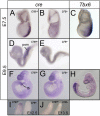Cell lineage of timed cohorts of Tbx6-expressing cells in wild-type and Tbx6 mutant embryos
- PMID: 28606934
- PMCID: PMC5550921
- DOI: 10.1242/bio.026203
Cell lineage of timed cohorts of Tbx6-expressing cells in wild-type and Tbx6 mutant embryos
Abstract
Tbx6 is a T-box transcription factor with multiple roles in embryonic development as evidenced by dramatic effects on mesoderm cell fate determination, left/right axis determination, and somite segmentation in mutant mice. The expression of Tbx6 is restricted to the primitive streak and presomitic mesoderm, but some of the phenotypic features of mutants are not easily explained by this expression pattern. We have used genetically-inducible fate mapping to trace the fate of Tbx6-expressing cells in wild-type and mutant embryos to explain some of the puzzling features of the mutant phenotype. We created an inducible Tbx6-creERT2 transgenic mouse in which cre expression closely recapitulates endogenous Tbx6 expression both temporally and spatially. Using a lacZ-based Cre reporter and timed tamoxifen injections, we followed temporally overlapping cohorts of cells that had expressed Tbx6 and found contributions to virtually all mesodermally-derived embryonic structures as well as the extraembryonic allantois. Contribution to the endothelium of major blood vessels may account for the embryonic death of homozygous mutant embryos. In mutant embryos, Tbx6-creERT2-traced cells contributed to the abnormally segmented anterior somites and formed the characteristic ectopic neural tubes. Retention of cells in the mutant tail bud indicates a deficiency in migratory behavior of the mutant cells and the presence of Tbx6-creERT2-traced cells in the notochord, a node derivative provides a possible explanation for the heterotaxia seen in mutant embryos.
Keywords: Cell fate; Lineage; Mouse; Mutant phenotype; T-box; Tbx6.
© 2017. Published by The Company of Biologists Ltd.
Conflict of interest statement
Competing interestsThe authors declare no competing or financial interests.
Figures






Similar articles
-
Tbx6, a mouse T-Box gene implicated in paraxial mesoderm formation at gastrulation.Dev Biol. 1996 Dec 15;180(2):534-42. doi: 10.1006/dbio.1996.0326. Dev Biol. 1996. PMID: 8954725
-
Dll1 is a downstream target of Tbx6 in the paraxial mesoderm.Genesis. 2005 Jul;42(3):193-202. doi: 10.1002/gene.20140. Genesis. 2005. PMID: 15986483
-
Functional roles of the Ripply-mediated suppression of segmentation gene expression at the anterior presomitic mesoderm in zebrafish.Mech Dev. 2018 Aug;152:21-31. doi: 10.1016/j.mod.2018.06.001. Epub 2018 Jun 4. Mech Dev. 2018. PMID: 29879477
-
Three neural tubes in mouse embryos with mutations in the T-box gene Tbx6.Nature. 1998 Feb 12;391(6668):695-7. doi: 10.1038/35624. Nature. 1998. PMID: 9490412
-
Axial stem cells deriving both posterior neural and mesodermal tissues during gastrulation.Curr Opin Genet Dev. 2012 Aug;22(4):374-80. doi: 10.1016/j.gde.2012.03.006. Epub 2012 May 9. Curr Opin Genet Dev. 2012. PMID: 22575683 Review.
Cited by
-
Tbx6 Induces Nascent Mesoderm from Pluripotent Stem Cells and Temporally Controls Cardiac versus Somite Lineage Diversification.Cell Stem Cell. 2018 Sep 6;23(3):382-395.e5. doi: 10.1016/j.stem.2018.07.001. Epub 2018 Aug 9. Cell Stem Cell. 2018. PMID: 30100166 Free PMC article.
-
Rare genetic causes of complex kidney and urological diseases.Nat Rev Nephrol. 2020 Nov;16(11):641-656. doi: 10.1038/s41581-020-0325-2. Epub 2020 Aug 17. Nat Rev Nephrol. 2020. PMID: 32807983 Free PMC article. Review.
-
The copy number variation landscape of congenital anomalies of the kidney and urinary tract.Nat Genet. 2019 Jan;51(1):117-127. doi: 10.1038/s41588-018-0281-y. Epub 2018 Dec 21. Nat Genet. 2019. PMID: 30578417 Free PMC article.
-
Human and mouse studies establish TBX6 in Mendelian CAKUT and as a potential driver of kidney defects associated with the 16p11.2 microdeletion syndrome.Kidney Int. 2020 Oct;98(4):1020-1030. doi: 10.1016/j.kint.2020.04.045. Epub 2020 May 22. Kidney Int. 2020. PMID: 32450157 Free PMC article.
-
Evolution of Somite Compartmentalization: A View From Xenopus.Front Cell Dev Biol. 2022 Jan 17;9:790847. doi: 10.3389/fcell.2021.790847. eCollection 2021. Front Cell Dev Biol. 2022. PMID: 35111756 Free PMC article.
References
-
- Beddington R. S. P. (1994). Induction of a second neural axis by the mouse node. Development 120, 613-620. - PubMed
Grants and funding
LinkOut - more resources
Full Text Sources
Other Literature Sources
Molecular Biology Databases

